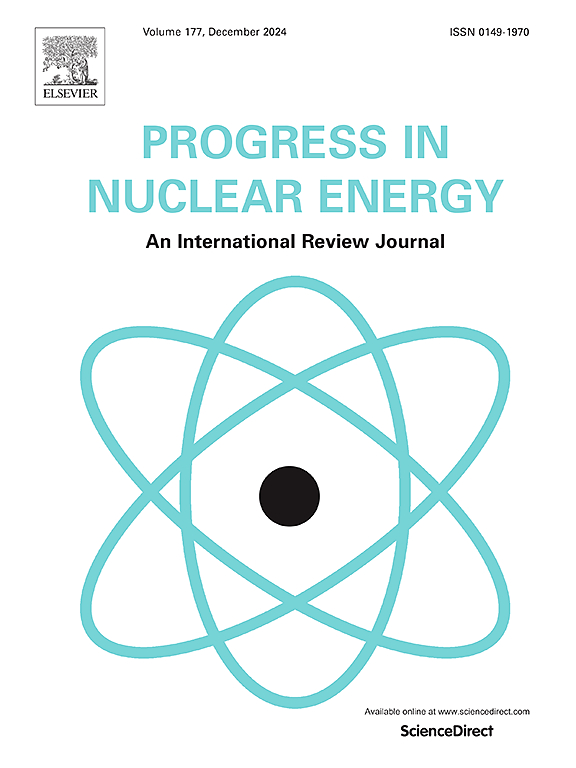Study on thermal-hydraulic performance of airfoil fin PCHE using vortex generators with different arrangement parameters for SCO2 Brayton cycle
IF 3.3
3区 工程技术
Q1 NUCLEAR SCIENCE & TECHNOLOGY
引用次数: 0
Abstract
The performance of the airfoil fin printed circuit heat exchanger (PCHE) is of great importance for the efficiency and size scale of Generation IV nuclear energy systems coupled to supercritical carbon dioxide (SCO2) Brayton cycles. Arranging vortex generator (VG) inside the airfoil fin channel could effectively enhance the comprehensive performance of PCHE, however, related studies are still limited. In particular, the study of the thermal-hydraulic characteristics of SCO2 in the PCHE channel with different arrangement parameters of the VG, which is important for the optimization of the PCHE performance, is very lacking. Therefore, it is of great significance to study the influence of parameters such as vertical spacing (La,VG) and horizontal spacing (Lb,VG) between the VG and the fin, the angle of attack (θ) and offset direction of the VG on the flow and heat transfer performance of the SCO2 in the PCHE flow channel. This study compares the flow and heat transfer performance of the channel with different arrangement parameters of VG, and reveals the flow and heat transfer mechanism of SCO2 in the channel. The results show that with the increase of La,VG, the thermal performance of the PCHE channel is weakened and then strengthened, and the flow performance is gradually weakened. With the increase of Lb,VG, the thermal performance of the PCHE channel is enhanced and then weakened, the flow performance is weakened, then enhanced and finally weakened. With the increase of θ, the thermal performance of the PCHE channel is gradually enhanced, while the flow performance is gradually weakened. The thermal performance of the PCHE channel is best when the VG deviation direction is different on both sides of the fin. Field synergy principle, entropy production principle, distribution of turbulent kinetic energy, distribution of vortex structure, and properties of SCO2 can well explain these. In addition, among the different VG arrangement parameters, La,VG of 0.7 mm, Lb,VG of 3 mm, θ of 45°, and the different direction of VG deviation on both sides of the airfoil fins are recommended.
采用不同布置参数的涡发生器研究SCO2布雷顿循环中翼型翅片PCHE的热工性能
翼型翅片印刷电路换热器(PCHE)的性能对第四代超临界二氧化碳(SCO2)布雷顿循环耦合核能系统的效率和规模具有重要意义。在翼型翅片通道内布置涡发生器(VG)可以有效提高PCHE的综合性能,但相关研究仍然有限。特别是对不同VG布置参数的PCHE通道中SCO2的热液特性的研究非常缺乏,而这对PCHE性能的优化至关重要。因此,研究涡盘与翅片之间的垂直间距(La,VG)和水平间距(Lb,VG)、涡盘的迎角(θ)和偏置方向等参数对PCHE流道中SCO2流动和换热性能的影响具有重要意义。本研究比较了不同VG布置参数下通道的流动传热性能,揭示了SCO2在通道内的流动传热机理。结果表明:随着La、VG的增加,PCHE通道的热性能先减弱后增强,流动性能逐渐减弱;随着Lb、VG的增加,PCHE通道的热性能先增强后减弱,流动性能先减弱后增强最后减弱。随着θ的增大,PCHE通道的热性能逐渐增强,流动性能逐渐减弱。当翅片两侧VG偏离方向不同时,PCHE通道的热性能最好。场协同原理、熵产生原理、湍流动能分布、涡结构分布以及SCO2的性质都可以很好地解释这些现象。此外,在不同的VG布置参数中,推荐了La,VG为0.7 mm, Lb,VG为3 mm, θ为45°,以及翼型两侧不同方向的VG偏差。
本文章由计算机程序翻译,如有差异,请以英文原文为准。
求助全文
约1分钟内获得全文
求助全文
来源期刊

Progress in Nuclear Energy
工程技术-核科学技术
CiteScore
5.30
自引率
14.80%
发文量
331
审稿时长
3.5 months
期刊介绍:
Progress in Nuclear Energy is an international review journal covering all aspects of nuclear science and engineering. In keeping with the maturity of nuclear power, articles on safety, siting and environmental problems are encouraged, as are those associated with economics and fuel management. However, basic physics and engineering will remain an important aspect of the editorial policy. Articles published are either of a review nature or present new material in more depth. They are aimed at researchers and technically-oriented managers working in the nuclear energy field.
Please note the following:
1) PNE seeks high quality research papers which are medium to long in length. Short research papers should be submitted to the journal Annals in Nuclear Energy.
2) PNE reserves the right to reject papers which are based solely on routine application of computer codes used to produce reactor designs or explain existing reactor phenomena. Such papers, although worthy, are best left as laboratory reports whereas Progress in Nuclear Energy seeks papers of originality, which are archival in nature, in the fields of mathematical and experimental nuclear technology, including fission, fusion (blanket physics, radiation damage), safety, materials aspects, economics, etc.
3) Review papers, which may occasionally be invited, are particularly sought by the journal in these fields.
 求助内容:
求助内容: 应助结果提醒方式:
应助结果提醒方式:


